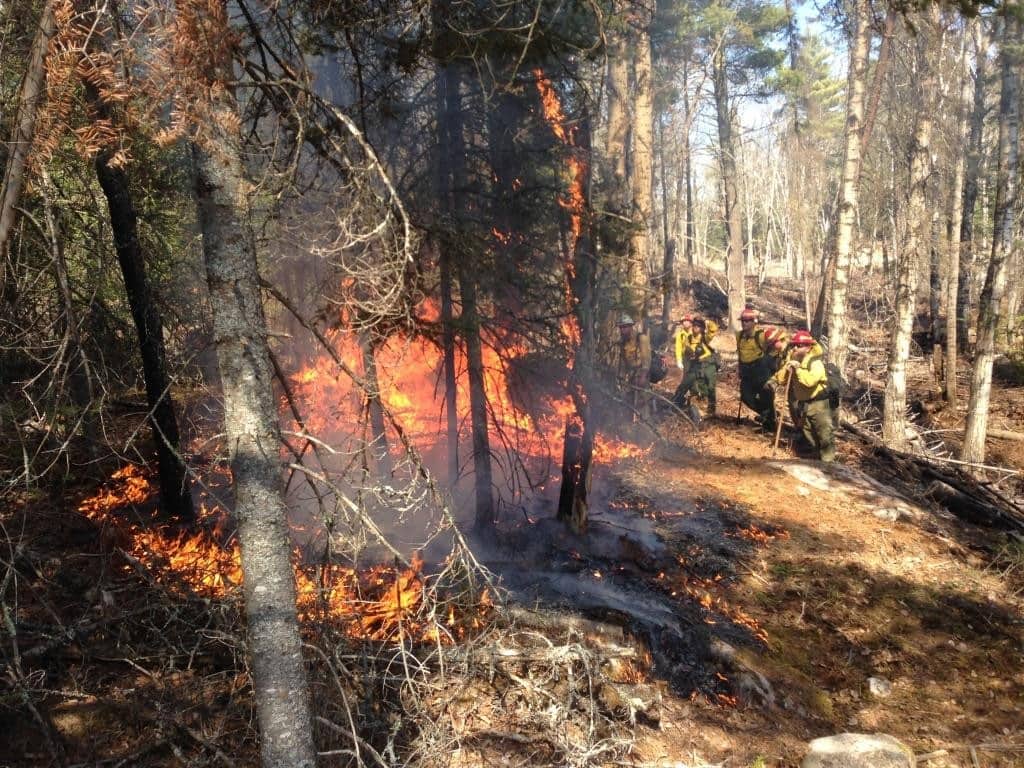
Multiple fires will be ignited this fall across the Boundary Waters Canoe Area Wilderness to reduce the amount of flammable material, mostly in areas affected by the Fourth of July blowdown storm of 1999. Twenty years after half a million acres of trees were knocked down on the Superior National Forest, managers say a wildfire could cause devastating damage if it started inside the wilderness and spread to developed areas nearby.
About 10 percent of the blowdown area has been intentionally burned in the past two decades, and much remains. Because downed trees were stacked on each other by the straightline winds, many logs were left high off the ground, slow to decay, and drying into dangerous condition.
Prescribed fires are planned to start as soon as next week, on Sept. 3, and continue through October. Exactly what projects can be accomplished and when will be largely determined by weather, forest conditions, and staff and other resource availability.
“Prescribed fires are carefully planned in advance, with involvement from specialists in all of the resource programs on the Forest and designed to be implemented under specific conditions (prescription) to meet management objectives,” the Superior National Forest wrote.
Areas planned for prescribed fires include near Crab and Basswood Lakes on the Ely side, and Duncan and Lux Lakes off the Gunflint Trail. The fires will result in entry point, portage, campsite and lake closures. Wilderness visitors who have a permit reservation during the wilderness quota season, which runs until Oct. 1, will be notified a week in advance if their route will be affected.
“The Forest Service has demonstrated over the past fifteen years, the use of prescribed fire under favorable conditions reduces the concentrations of hazardous fuels created by the storm,” the agency wrote. “This improves public safety by creating conditions that will decrease fire intensities and the rate of fire spread in the event of a wildfire, providing firefighters time to implement suppression and containment activities as well as evacuations if needed.”
Fire is considered a normal part of the Boundary Waters ecosystem, playing an essential role in keeping forests healthy. The intent is that the burns should help the forest continue to regenerate after the blowdown, in the absence of lightning-ignited wildfires, while making it safer to let natural fires in the wilderness burn if possible.
The Duncan Lake prescribed fire will total approximately 5,700 acres and the Lux Lake will add up to about 3,200 acres, reports the Duluth News Tribune. On the western side of the wilderness, the Basswood Lake fire will be 1,700 acres and the Crab Lake Fire will be 2,100 acres.

The Forest Service is authorized to use limited motorized equipment like chainsaws, water pumps, and boats in the wilderness area before and during the burns. WTIP.org reports Patty Johnson, the zone fire management officer for the Gunflint and Tofte districts “said motorized equipment will only be used as needed, noting that crosscut saws and other non-mechanized equipment is currently being used to prep for the prescribed fires.”
All the projects were studied as part of a 2001 environmental review on reducing fire fuel in the wilderness after the blowdown. The review was updated in 2016.
For more information, call the Superior National Forest’s West Zone Fire Information phone at 218-248-2411 or the Gunflint Ranger District at 218-387-1750. Information on active fires is posted on InciWeb.
More information:
- Superior National Forest plans fall prescribed fire activity – U.S. Forest Service
- Supplemental Information Report – Boundary Waters Canoe Area Wilderness Fuel Treatment Final Environmental Impact Statement (PDF)
- Duncan Lake Prescribed Fire – Fact Sheet (PDF)
- Lux Lake Prescribed Fire – Fact Sheet (PDF)

